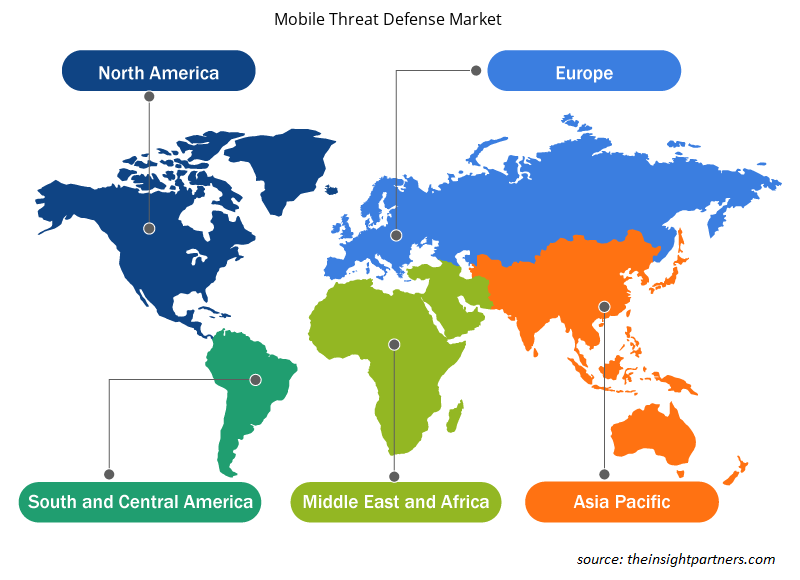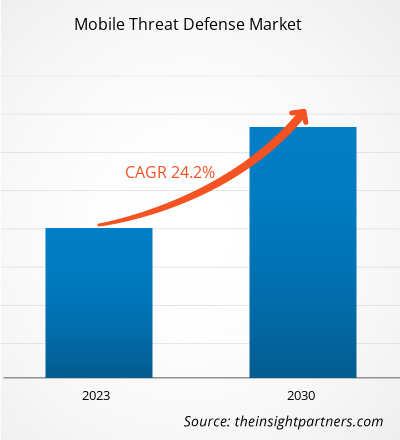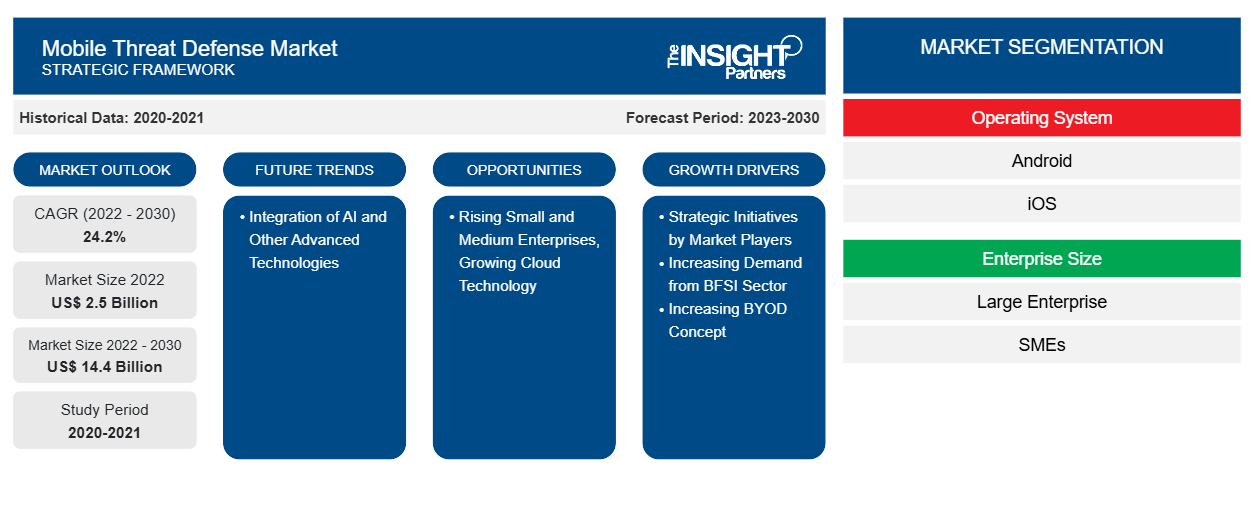移动威胁防御市场规模预计将从 2022 年的 25 亿美元增至 2030 年的 144 亿美元。预计 2022-2030 年期间该市场的复合年增长率将达到 24.2%。预计在预测期内,人工智能和其他先进技术的融合将为移动威胁防御市场带来关键趋势。
移动威胁防御市场分析
在 COVID-19 疫情期间,数字化在当今的商业环境中至关重要。企业采用各种策略和解决方案,在采用数字化的同时确保组织信息的安全。移动威胁防御 (MTD) 是一种解决移动应用程序上的恶意软件攻击和网络威胁的策略。随着人们对移动上网的依赖性相对于桌面浏览的增加,移动设备上的数据盗窃、黑客攻击和勒索软件攻击的增加也在增加,这进一步推动了对 MTD 解决方案的需求。除了保护移动软件外,MTD 还保护移动设备的其他部分,包括保存的数据、应用程序、网络流量以及与用户移动设备相关的其他个人数据。
许多公司允许员工使用自己的设备工作,以降低成本并提高产量。这有时被称为“自带设备”政策,简称 BYOD。BYOD 概念的兴起是产生对移动威胁防御解决方案需求的主要因素。
移动威胁防御市场概览
移动威胁防御 (MTD) 是一种针对网络威胁的移动设备高级保护解决方案。MTD 解决方案适用于设备、网络和应用程序。许多组织允许员工使用移动设备工作,这使组织的关键信息面临风险。因此,组织采用安全解决方案来确保企业的移动安全。MTD 应用程序通过检查操作系统 (OS) 版本、固件、系统参数和设备配置来监控移动设备上的威胁,以发现任何异常和其他漏洞。这些解决方案不断扫描可疑活动,例如用户通过特权升级未经授权进入网络。移动用户面临各种攻击,包括网络钓鱼、恶意应用程序和中间人攻击。移动威胁防御解决方案监控网络流量中的可疑活动。它还分析代码并对应用程序进行逆向工程以发现灰色软件和恶意软件。
采用 MTD 解决方案可增强组织采用 BYOD 政策的信心,在攻击成为严重问题之前阻止攻击,了解移动员工的风险水平,并保护公司的敏感数据(无论位于何处)。因此,这些安全解决方案的这些好处增加了其需求并推动了移动威胁防御市场规模。
定制此报告以满足您的需求
您可以免费定制任何报告,包括本报告的部分内容、国家级分析、Excel 数据包,以及为初创企业和大学提供优惠和折扣
- 获取此报告的关键市场趋势。这个免费样品将包括数据分析,从市场趋势到估计和预测。
移动威胁防御市场驱动因素和机遇
数字支付的兴起
近年来,数字支付生态系统发展迅猛。互联网普及和智能手机使用率上升是推动数字支付增长的一些主要因素。新冠疫情爆发后,网上购物和电子商务行业发展迅猛,推动了网上金融交易的增长。根据世界银行在《2021 年全球金融包容性指数数据库》中的信息,除中国外,发展中经济体约 40% 的成年人通过电话、信用卡或互联网进行数字商户支付,超过三分之一的发展中经济体成年人直接从账户支付水电费。这些交易都是疫情爆发后首次发生的。因此,数字交易的数量逐年增长。根据 Razorpay 的数据,2021 年的在线支付增长了一倍多,与 2020 年相比增长了 104%。
同样,ACI Worldwide 声称,2020 年全球处理的实时支付交易超过 703 亿笔,与 2019 年相比激增 41%。越来越多的人开始采用和偏爱在线交易,这使移动设备面临更高的网络威胁风险。因此,MTD 解决方案有助于保护移动银行和支付。它有助于实时保护个人/组织的移动设备免受高级网络钓鱼、设备、网络和应用程序网络攻击。随着数字支付系统的兴起,对安全解决方案的需求激增,推动了移动威胁防御市场的增长。
移动威胁防御市场报告细分分析
“移动威胁防御市场分析”考虑了以下几个部分:操作系统、企业规模、垂直行业和地理位置。根据操作系统,市场分为 Android 和 iOS。根据企业规模,市场分为大型企业和中小型企业。根据最终用户,市场分为 IT 和电信、BFSI、制造业、零售和电子商务、政府等。
移动威胁防御市场份额分析(按地区)
移动威胁防御市场报告的地理范围主要分为北美、欧洲、亚太地区、中东和非洲以及南美和中美洲。就收入而言,北美在 2022 年占据了移动威胁防御市场份额的主导地位,预计亚太地区在预测期内将录得最高的复合年增长率。
北美是技术创新以及人工智能、区块链和其他先进技术在所有主要垂直行业的采用方面增长最快的地区之一。随着数字化在各个行业的渗透率不断提高,MTD 已成为商业生态系统的基本组成部分,尤其是为移动设备带来安全性。企业对移动威胁防御解决方案的需求正在迅速增长,因为这些解决方案允许企业为暴露于潜在网络威胁的移动设备提供端点安全。北美移动威胁防御市场份额主要受 BFSI、IT 和电信、制造业、政府和其他行业不断增长的需求推动,其中移动威胁防御不仅可以保护移动软件,还可以为移动设备的其他组件提供安全保护,包括网络流量、应用程序、存储的数据和其他个人信息。
移动威胁防御市场新闻和最新发展
通过收集主要和次要研究的定性和定量数据来评估移动威胁防御市场,其中包括重要的公司出版物、协会数据和数据库。根据公司新闻稿,移动威胁防御市场的主要发展如下:
- 2023 年 11 月,Zimperium 宣布支持澳大利亚政府,在澳大利亚主权数据中心启动其移动威胁防御 (MTD) 解决方案的 IRAP 评估,这使机构和关键基础设施组织能够完美地采用移动威胁防御功能来检测和监控移动漏洞并保护数据。
- 2022 年 6 月,博通宣布推出移动威胁防御解决方案 Workspace ONE 系列。该解决方案是与 Workspace ONE Intelligent Hub 的新集成。顾名思义,它为 Android、iOS 和 Chrome OS 移动设备提供针对威胁的高级保护。该解决方案用于抵御来自恶意软件、网络钓鱼、恶意内容、中间人攻击、恶意网络等的威胁。
- 2018 年 2 月,Orange Cyberdefense 与 Check Point Software Technologies 合作,推出了一项名为“移动威胁防护”的 Orange 新服务。通过这项服务,两家公司旨在帮助跨国企业保护其移动设备免受现有和新兴威胁的侵害。
- 2023 年 6 月,Pradeo 发布了最新移动威胁防御版本,为 MSSP 带来了无与伦比的优势。Pradeo 最新版本的移动威胁防御解决方案提供了交钥匙功能,旨在与 MSSP 现有的产品顺利融合,并大幅缩短管理时间。
- 2022 年 5 月,屡获殊荣的移动安全解决方案提供商 Corrata 与 Three UK 合作,将 Corrata 的移动威胁防御解决方案带给 Three UK 的商业客户。Corrata 的移动威胁防御解决方案通过易于部署、易于管理的解决方案为组织提供针对各种移动网络攻击(包括短信网络钓鱼、恶意软件和 Wi-Fi 黑客)的保护。此次发布得到了其合作伙伴 CWSI 的支持。
- 2023 年 1 月,Ivanti 和 Lookout, Inc. 宣布扩大战略合作伙伴关系,将 Lookout Mobile Endpoint Security 纳入 Ivanti Neurons 自动化平台。该组合解决方案包括 Ivanti Go 和 Ivanti Neurons for Modern Device Management,是一流的安全和管理解决方案,可帮助 Ivanti 客户部署移动战略,以保护混合劳动力,同时降低组织的整体风险。统一端点管理和移动威胁防御相结合,使组织能够主动管理和保护移动设备,以抵御最广泛的攻击,并防御基于 Web 的复杂攻击。
移动威胁防御市场区域洞察
Insight Partners 的分析师已详细解释了预测期内影响移动威胁防御市场的区域趋势和因素。本节还讨论了北美、欧洲、亚太地区、中东和非洲以及南美和中美洲的移动威胁防御市场细分和地理位置。

- 获取移动威胁防御市场的区域特定数据
移动威胁防御市场报告范围
| 报告属性 | 细节 |
|---|---|
| 2022 年市场规模 | 25亿美元 |
| 2030 年的市场规模 | 144亿美元 |
| 全球复合年增长率(2022 - 2030 年) | 24.2% |
| 史料 | 2020-2021 |
| 预测期 | 2023-2030 |
| 涵盖的领域 | 按操作系统
|
| 覆盖地区和国家 | 北美
|
| 市场领导者和主要公司简介 |
|
移动威胁防御市场参与者密度:了解其对业务动态的影响
移动威胁防御市场正在快速增长,这得益于终端用户需求的不断增长,而这些需求又源于消费者偏好的不断变化、技术进步以及对产品优势的认识不断提高等因素。随着需求的增加,企业正在扩大其产品范围,进行创新以满足消费者的需求,并利用新兴趋势,从而进一步推动市场增长。
市场参与者密度是指在特定市场或行业内运营的企业或公司的分布情况。它表明在给定市场空间中,相对于其规模或总市场价值,有多少竞争对手(市场参与者)存在。
在移动威胁防御市场运营的主要公司有:
- 思科系统公司
- 伊万蒂
- 思爱普
- 博通
- AO卡巴斯基实验室
- 辛佩里姆
免责声明:上面列出的公司没有按照任何特定顺序排列。

- 获取移动威胁防御市场顶级关键参与者的概述
移动威胁防御市场报告覆盖范围和交付成果
“移动威胁防御市场规模和预测(2022-2030)”报告对以下领域进行了详细的市场分析:
- 范围内所有主要细分市场的全球、区域和国家层面的市场规模和预测
- 市场动态,如驱动因素、限制因素和关键机遇
- 未来的主要趋势
- 详细的 PEST/波特五力分析和 SWOT 分析
- 全球和区域市场分析涵盖关键市场趋势、主要参与者、法规和最新市场发展
- 行业格局和竞争分析,涵盖市场集中度、热点图分析、知名参与者和最新发展
- 详细的公司简介
- 历史分析(2 年)、基准年、预测(7 年)及复合年增长率
- PEST和SWOT分析
- 市场规模、价值/数量 - 全球、区域、国家
- 行业和竞争格局
- Excel 数据集
近期报告
相关报告
客户评价
购买理由
- 明智的决策
- 了解市场动态
- 竞争分析
- 客户洞察
- 市场预测
- 风险规避
- 战略规划
- 投资论证
- 识别新兴市场
- 优化营销策略
- 提升运营效率
- 顺应监管趋势





















 获取免费样品 - 移动威胁防御市场
获取免费样品 - 移动威胁防御市场